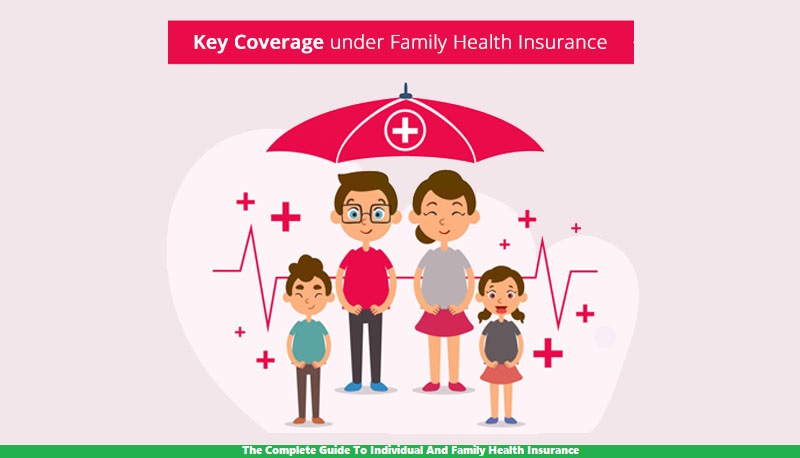So here is individual and family health insurance in one line. Both cover you or your family in case of sickness or injury. They also cover the doctor visits and tests before you fall sick. There is a lot that health insurance has got to offer. So, here we have compiled a complete guide to individual and family health insurance.
So, let’s start!
Basics Of Individual And Family Health Insurance
The first thing to know about individual and health insurance is that they do not cover the whole amount of the treatment. Yes, it is a common myth that the insurance guys do. In actuality, they share the payment depending on the metal tier (more on that later). The insurance people share your payment till a specific out-of-pocket limit. Once this limit is reached, they pay the full 100%.
All health insurance plans cover ten essential health services:
- Ambulatory Services
- Emergency Services
- Hospitalization
- Laboratory Services
- Maternity Care
- Mental Health Care
- Pediatric Services
- Prescription Drugs
- Preventive and Wellness Services
- Rehabilitative and Habilitative Services and Devices
All health insurance plans, whether public or private, have to provide these ten essential services. Plus, they also have to abide by some affordability rules and other federal laws.
Which Type of Health Insurance Should You Buy?
There are a plethora of insurance plans, each with its exclusive feature. So, let’s see which will suit you the most!
#1: Health Maintenance Organization (HMO)
An HMO allows its customers to take medical treatment from its contracted health professionals. The HMOs maintain a network of healthcare providers, and the customers can only contact them.
Also read: 5 Major Insurance Policies Everyone Should Have!
If you buy an HMO plan, you will need to pick up a PCP, i.e., a primary care physician. All your treatment will be taken care of by this physician. And if you need a specialist, your PCP will refer you to him.
An HMO does not cover any costs outside the network.
So, the pros of an HMO is that its premiums are low, while the con is the limited choice.
#2: Preferred Provider Organization (PPO)
Preferred Provider Organization or PPO allows you the most flexible plans. A PPO lets you see doctors at a subsidized rate. But, if you see an in-network doctor, you will pay less. On the other hand, if you see an out-of-network doctor, you will have to pay relatively more. But still, they will share some amount of bill.
Also, you do not need a PCP to refer you to a specialist. You can directly contact one. However, some states may require a PCP by law.
Owing to its flexibility and facilities; thereby, this health insurance plan has higher premiums than all other plans.
Thus, if you can afford a higher premium and want the flexibility a PPO provides, go for it!
#3: Exclusive Provider Organization (EPO)
Exclusive Provider Organization or EPO is a mix of HMO and PPO facilities.
An EPO does not let you access out-of-network doctors like an HMO. But it does allow you to access a specialist without the referral of a PCP. However, you will need to choose a PCP who will provide you with preventative care and treat minor illnesses.
So, if you don’t mind reaching out to an in-network doctor and instead prefer not going through the PCP for a specialist, EPO is the one for you. Also, EPO plans are priced lower than PPO plans and higher than HMO plans.
#4: Point Of Service (POS)
POS is another mix of HMO and PPO facilities.
In POS, you get access to an HMO-style network. Here you can only consult in-network doctors and need a PCP’s referral for seeing a specialist. But you also get a PPO-style network where you can access out-of-network doctors. However, the price is relatively high, as is the case with PPO plans. Also, you do not need a PCP referral.
Also read: Complete Guide On The Advantages And Disadvantages Of Life Insurance?
So, with POS, you get the best of both the worlds. The affordability of HMO and the flexibility of PPO. POS plans like EPO are more affordable than PPO and more expensive than an HMO.
Thus go for POS if you want the ultimate flexibility and do not want to miss out on any plan’s features. Plus, it’s quite affordable too.
What Are The Metal Tiers?
Remember we mentioned that insurance companies don’t pay the whole amount but pay according to the metal tiers.
A common misconception is that metal tiers define the level of quality service or quality of the plan. But it is not so. Metal tiers represent the share of medical bills between you and the insurance company. So, here is how they split costs:
| Metal Tier | Consumer | Insurer |
| Bronze | 40% | 60% |
| Silver | 30% | 70% |
| Gold | 20% | 80% |
| Platinum | 10% | 90% |
For obvious reasons, premiums for bronze are less than silver, and lesser for silver than gold and so on. But a point to note here is that if you utilize your insurance often, you may pay more in a bronze plan than a silver plan.
Also read: What to know about short term health insurance?
Also, these percentages do not include premiums paid for the policy.
Key Features
#1: Premiums
Premiums are the charge you pay to keep your insurance coverage on. These are usually paid monthly. So, you can compare these to your monthly phone or electricity bill.
#2: Deductible
Before your insurance pays, you have to pay a certain amount of money, which is called a deductible. Lower premiums mean a higher deductible and vice versa.
#3: Copayment
It is the flat fee you need to pay before availing of any medical procedure or benefit. For example, every time you visit your doctor, you need to pay a certain copay fee for it.
#4: Coinsurance
Coinsurance is a percentage of the bill you always pay for any covered service. You pay for it after your deductible has been paid.
#5: Maximum Out-of-pocket Amount
It is the maximum amount you will have to pay yearly except for the premiums. Your deductibles, copay, and coinsurance all make up the out-of-pocket amount.
Conclusion
So, pay attention to the details like the type of plan, the metal tier, and other critical features of your plan. Ask your agent everything about the plan and then finalize a plan that yields the most benefit to you.
So, this was all in our guide to individual and family health insurance. We hope you liked it and that it was useful. If you have any questions buzzing in your mind, drop them in the comments section below. We will answer ASAP!







